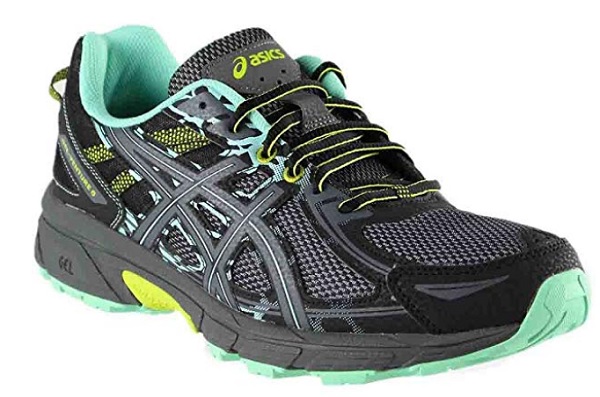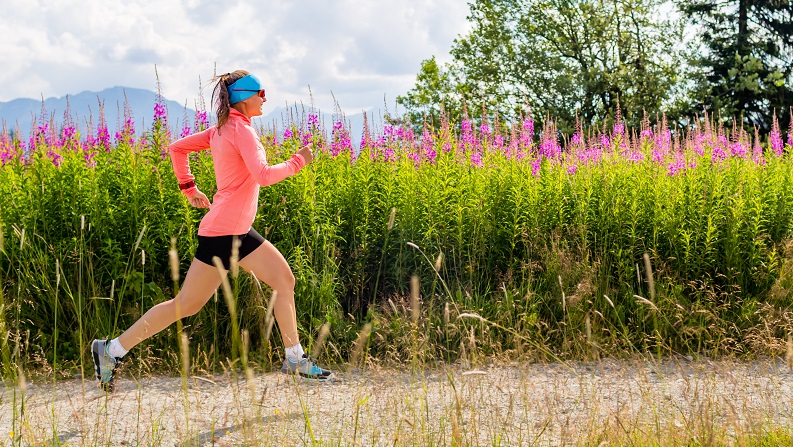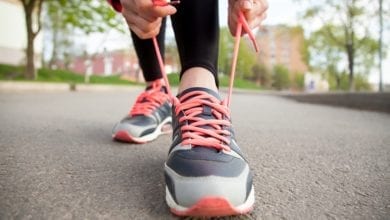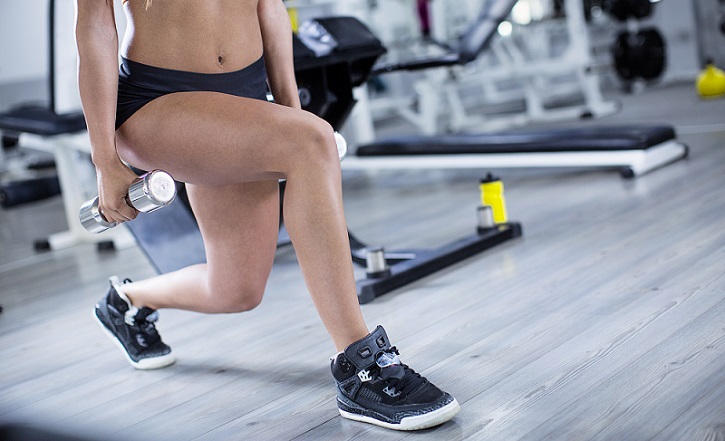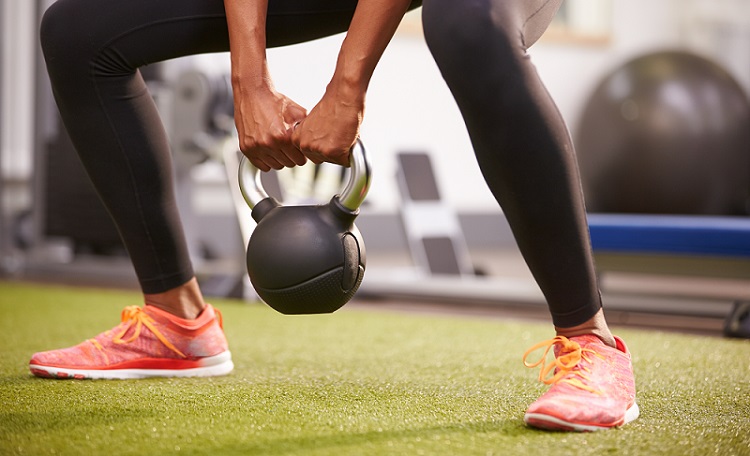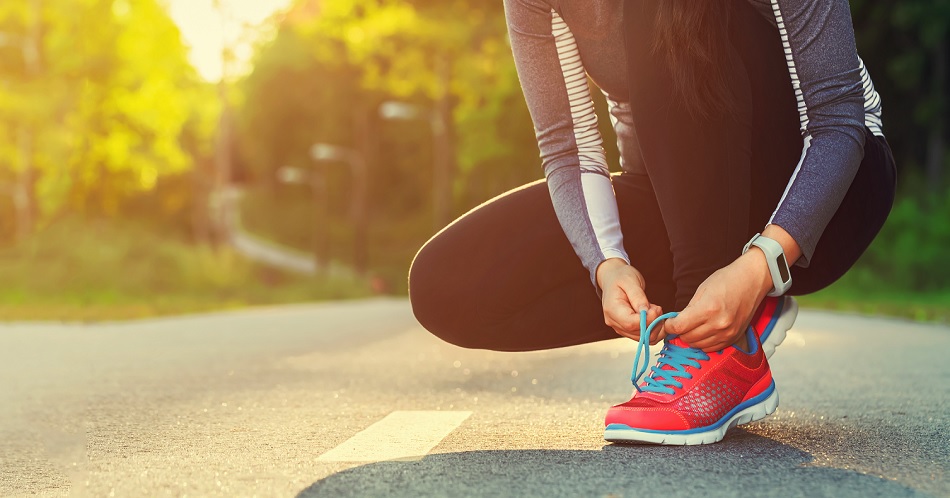
Our Editors independently research, test, and rate what we feel are the best products. We use affiliate links and may receive a small commission on purchases.
There are many reasons why running is good for you. You are losing weight, strengthening your lower legs, and working to prevent many chronic health conditions.
However, even though running is one of the most natural cardio exercises you can do, it can still cause injury. Most injuries runner’s experience is known as “runner’s knee” and while it can affect your run and your training, but it is preventable!
A good way to prevent knee pain while running is to wear the best running shoes for bad knees. No one person’s foot will be just like another, so finding the right pair of running shoes for you is important. Ready to get started?
Best Women’s Running Shoes For Bad Knees
| ASICS Gel-Venture 6 Running-Shoes | HOKA ONE ONE Bondi 6 Running Shoes | Mizuno Wave Rider 20 Running Shoe | |
|---|---|---|---|
| Upper: | Synthetic Mesh | Fabric / Textile | Synthetic Mesh |
| Sole: | Rubber | Rubber | Rubber |
| Sizes: | 5 to 12, Average/Narrow/Wide | 5 to 11, Average/Narrow/Wide | 6 to 12, Average/Narrow/Wide |
| Type of Gait: | Underpronating/High Arches | Overpronating | Neutral |
For more of my running gear recommendations, have a look through these popular Women’s Workout guide links: Hydration Vests, Running Leggings, Running Shorts.
Quick Answer: The 5 Best Rated Running Shoes For Bad Knees
- ASICS Women’s Gel-Venture 6 Running-Shoes
- HOKA ONE ONE Hoka Bondi 5 Women’s Running Shoes
- Mizuno Women’s Wave Rider 20 Running Shoe
- ASICS Women’s Gel-Kayano 24 Running Shoe
- Brooks Glycerin 15 Neutral Max Cushion Running Shoe
Our reviews of the top running shoes for bad knees with our buyers guide and comparison table will help you choose the right pair for you.
Women’s Running Shoes For Bad Knees Reviews
We’ve chosen these running shoes specifically for runners who suffer from knee pain. Whether your knee pain is caused by jogging or a previous injury, having the proper footwear can get you back on the road, or trail, quickly.
#1 ASICS Women’s Gel-Venture 6 Running-Shoes
- Sizes: 5 to 12, Average/Narrow/Wide
- Colors: 11 Options
- Type of Gait: Underpronating/High Arches
- Uppers: Synthetic Mesh
A newer name in the Asics line of running shoes is the Venture 6. It utilizes the same GEL technology in the rear foot as that seen in the Kayano 24.
This makes for a smooth, cushioned feel during heel-to-toe transition that helps make them the best running shoes for bad knees. Also working to reduce the impact shock in your joints, especially knees, is the design.
Those who have high arches and underpronate can experience a stronger impact as that impact is mostly on the outer edge of the foot instead of the entire surface.
The Asics GEL Venture 6 works to correct the impact surface of the foot.
If you find yourself mostly running on a trail, you want a shoe that can keep up with the changes in stability and quick movements you will be making.
The Venture 6 has the traction you need for trail running but is also well made when it comes to road running as well. Adding to the durability of the shoe is the Asics-designed AHAR, or Asics High Abrasion Rubber.
#2 HOKA ONE ONE Hoka Bondi Women’s Running Shoes
- Sizes: 5 to 11, Average/Narrow/Wide
- Colors: 19 Options
- Type of Gait: Overpronating
- Uppers: Fabric / Textile
The Hoka brand has been known for trail-running for quite sometime.
However, the One Bondi 6 is the 6th generation of their first on-road running shoe and they’ve created one of the best cushioned running shoes for bad knees.
If you’ve found success with Hoka’s trail running shoes and are looking for something road-worthy, the Hoka One One Bondi 5 is for you.
This newest generation features a full-length midsole for support as well as an Ortholite insole for both cushion and arch support.
A newly designed Meta Rocker helps to support any roll you may have as you transition from heel-to-toe. All of these very supportive technologies work together to make this shoe ideal for overpronators with a high arch.
It is also ideal for heavier runners who need a more supportive and durable shoe. While the shoe has a bulky look, it is extremely lightweight.
#3 Mizuno Women’s Wave Rider 20 Running Shoe
- Sizes: 6 to 12, Average/Narrow/Wide
- Colors: 9 Options
- Type of Gait: Neutral
- Uppers: Synthetic Mesh
Mizuno may not be the first name you think of when it comes to choosing your new shoes, but perhaps it should be, as they create the best womens running shoes for bad knees.
This company has been designing some great running shoes for years. The Mizuno Wave Rider 20 is the latest generation of their best-selling running shoes.
There’s a reason for the name, too. There is a plate in the shoe, shaped like a wave, that disperses the impact of each foot strike.
When the impact can be spread out across the entire foot, it reduces the shock on the joints, especially the ankles, knees, and hips.
The insole of the Wave Rider 20 running shoes is removeable, allowing you to use custom or prescription orthotics with your favorite running shoes.
The upper, designed with an engineered mesh fabric, isn’t just to increase breathability.
It also allows movement where it should and a strong hold where it’s needed. With the Mizuno Wave Rider 20 running shoes, you have comfortable cushion as well as durability in a very lightweight design.
#4 ASICS Women’s Gel-Kayano 24 Running Shoe
- Sizes: 5 to 13, Average/Narrow/Wide
- Colors: 11 options
- Type of Gait: Overpronator
- Uppers: Synthetic Mesh
The Asics brand will be found on every list of top running shoes and they have many models that help those with different pronation, joint issues, and more.
The Asics GEL Kayano 24 is their newest model in the Kayano line, which has quickly found fame in the running world. In fact, it is one of Asics’ top selling models.
A lot of technology has gone into the design and fit of these running shoes.
The GEL technology right in the name helps to create cushion in both the rear foot and forefoot and this technology helps make them good running shoes for bad knees.
This, along with their Impact Guidance System, helps to create a smooth transition from heel-to-toe, also absorbing much of the shock of each strike.
The FluidRide midsole reduces the weight of the shoe while also making them more durable. Along with that, the Fluid Fit Upper creates a stretch for the perfect fit while also adapting to your foot in a multidirectional way.
#5 Brooks Glycerin 15 Neutral Max Cushion Running Shoe
- Sizes: 5 to 12, Average/Narrow/Wide
- Colors: 7 Options
- Type of Gait: Neutral, Medium/High Arch
- Uppers: Synthetic Mesh
Brooks has long been known as a company who cares about the runners wearing their shoes.
If you are a long-distance runner and need running shoes for bad knees, the new Brooks Glycerin 15 are a great option.
If you are runner tired of buying a new pair of running shoes every month, it seems, you might want to give these a look.
Brooks understands the needs of determined runners, offering a high-mileage running shoe. Marathoners and casual runners alike will find the Glycerin 15 a great choice.
This shoe is supportive everywhere it should be while also being lightweight. A transition zone has been designed to give a smooth, comfortable heel-to-toe transition.
Their proprietary cushioning design, called SuperDNA, allows the shoe to absorb much of the impact upon foot strike, also keeping that shock away from the knees.
The upper is designed to very breathable, stretchable where it needs to be, and look great with a 3D print.
Running Shoes For Knee Pain Comparison Table
| Running Shoes | Upper | Sole | Sizes | Colors | Rating | |
|---|---|---|---|---|---|---|
| ASICS Gel-Venture 6 | Synthetic Mesh | Rubber | 5 to 12, Average/Narrow/Wide | 11 | 4.3 / 5.0 | |
| HOKA ONE ONE Bondi 5 | Fabric / Textile | Rubber | 5 to 11, Average/Narrow/Wide | 19 | 4.4 / 5.0 | |
| Mizuno Wave Rider 20 | Synthetic Mesh | Rubber | 6 to 12, Average/Narrow/Wide | 9 | 4.5 / 5.0 | |
| ASICS Gel-Kayano 24 | Synthetic Mesh | Rubber | 5 to 13, Average/Narrow/Wide | 11 | 4.5 / 5.0 | |
| Brooks Glycerin 15 | Synthetic Mesh | Synthetic | 5 to 12, Average/Narrow/Wide | 7 | 4.5 / 5.0 |
How to Choose the Best Running Shoes for Knee Pain – Buyers Guide
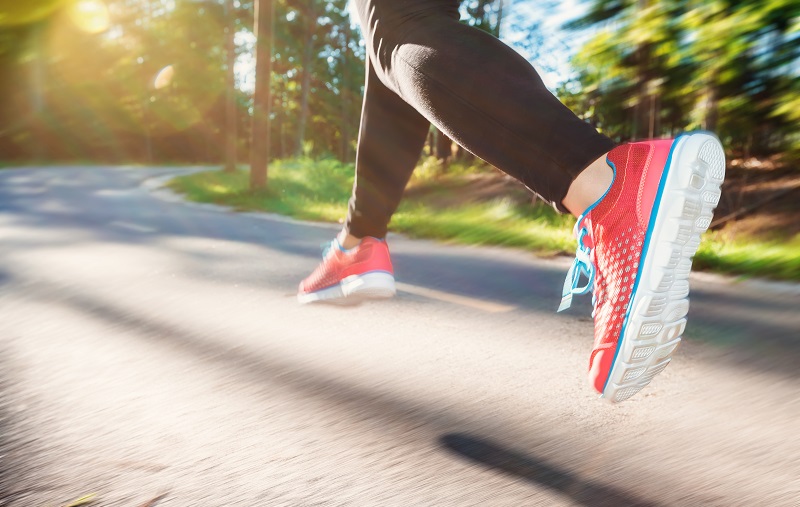
Every runner is going to need a different type of running shoe when it comes to preventing or decreasing knee pain. It is important to look at how each shoe will help, or hurt, your run. For example, your pronation, or lack of it, should determine the type of shoes you choose.
Take a look at these 5 factors you should take into consideration when choosing your new running shoe.
Pronation
An overpronator often has a high arch, but not always, where the inside part of the foot moves quite a bit downward with each step. A person who underpronates will usually have a low arch, or even flat feet, so that the inner part of the foot doesn’t move very much at all.
Somewhere between an overpronator and an underpronator is a neutral gait. Taking a few steps with wet feet on a surface that will show the footprint left behind, such as concrete, can tell you quite a bit about your gait and how to choose shoes for bad knees.
Stability
Those who overpronate will need a running shoe that offers more stability to the inner edge of the foot, preventing it from rolling inward. It will usually have a higher arch support as well.
Those who underpronate need a smaller arch support and prevent rolling as well. A running shoe designed with a neutral gait in mind are perfect for use with a neutral gait but can also be good for both overpronators and underpronators if the condition isn’t severe.
Breathability
Runners who are experiencing knee pain are most likely going out for high-mileage runs. Those long runs especially marathons can cause some very annoying effects. Short-term, you may experience sweaty, hot feet during your run.
Long-term, this heat and sweat can cause a smelly problem that may not be curable without purchasing a new pair. Continuing to use them can lead to bacteria infections.
Cushion
Depending on how hard you strike the ground with each stride, cushion may be something you need to focus on specifically or may not help you. However, the right cushion will help to absorb the impact that your heel strikes cause in the ankles and knees.
Most of the time, the right amount of cushion, that also provides support, can reduce or even eliminate knee pain while running. The Hoka One One Bondi 5 is one of the best cushioned running shoes for bad knees.
Durability
Your running shoes should stand up to the miles you intend to put on them. A durable running shoe like the Brooks design featured above, can last you much longer than those that aren’t made for hardcore, long-distance runner.
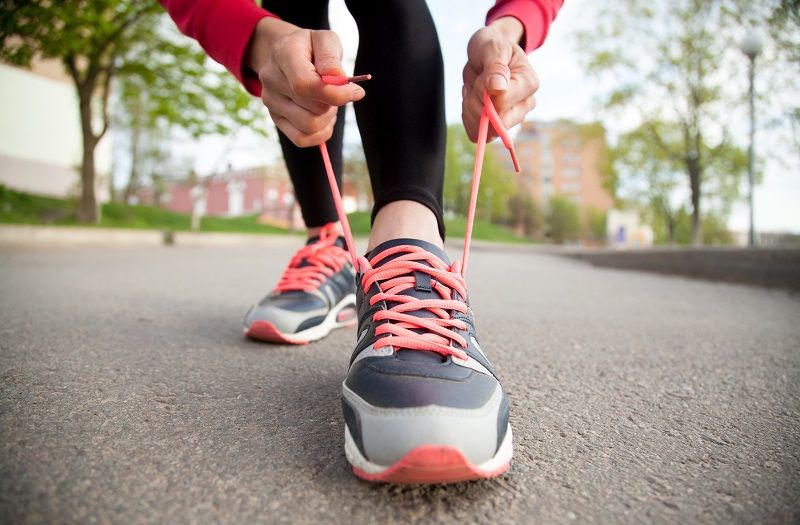
FAQ About Running Shoes For Knee Pain
Have questions about running shoes or how to run given your knee pain? Many runners experience knee pain at some point, but how do you handle it and prevent it from happening again?
Q: How often should I replace my running shoes?
A: There isn’t a hard and fast answer about how often you need to replace your running shoes. Some say every 300 miles and some say 600 miles. However, the way you run, how far you run, and the terrain you run will all impact the life of the shoes themselves.
However, if you are starting to notice aches and pains that you didn’t before, it may be time to invest in a new pair. Running shoes for bad knees should be replaced often as they wear out.
Q: I’ve heard about leaning forward when I run. Does it help with knee pain?
A: When you shift your weight while running, it impacts the shock on the joints as well. To reduce the impact of your foot falls on the knees, and shift it upward toward the hips, you can lean forward slightly while running. The hips, with much more muscle support from the upper legs and your core, are able to absorb the impact much more effectively than the knees.
Q: How fast should I increase my training?
A: If you are a relatively new runner, you want to take your time in increasing the duration and strength of your training. It takes the body quite some time to be able to handle more intense workouts.
If your body isn’t ready for the stress of longer, harder runs, you can increase the chances of a running-related injury. Both experienced and novice runners should listen to their body when it comes to increasing your training.
Q: What are the most common running injuries I need to prevent?
A: It isn’t just sore knees that show up when running. The typical knee pain associated with runners is known commonly as Runner’s Knee. It creates pain around the kneecap itself as well as on the outside edge of the knee. Another common running injury that effects the knee is called medial meniscal injury.
This refers to damage to the cartilage in the effected knee. Shin splints are also common, but very easily remedies with the right shoes as well. If you are feeling pain in the back of the ankle, you may be suffering from Achilles Tendinopathy, or inflammation of the Achilles tendon. The right shoes can prevent this as well.
Q: How important are stretching and warm up?
A: Many of the above ailments common with runners can be prevented or improved if you spend the few minutes before your run, preparing your body for the stress a long run can cause. Stretching comes first to loosen up the muscles in your core and legs.
Then you should warm up your muscles with some running in place or other such exercise that allows you to control how fast your legs warm up. After your run, try to cool off your muscles with additional stretches and slower exercise. It isn’t just having running shoes for bad knees, you need to make sure your body is ready for the run too. Don’t forget about hydration, use a hydration vest or a belt with water bottles.
Tips For Running With Knee Pain
Want to make sure you are getting the most out of every run? We have some helpful tips for you when it comes to wearing the right running shoes and how to put those shoes to good use.
Tip #1: Wearing the Right Running Shoes Matters
The best running shoes for knee pain, and even the wrong running shoes, can impact your running game. Make sure it is in a positive way and not causing you pain or injury. Make sure your shoes are the right size, offer plenty of room in the toe box along with a cushioned heel for smooth heel-to-toe transitions, as well as the support you need for your particular gait.
Tip #2: Strengthen More Than Just Your Legs
Your legs become stronger as you continue to run, especially after a long period of time. However, your leg muscles are the only ones you use when you run. Your upper leg and core muscles help to stabilize your lower body. If you strengthen these through regular strength training, you can reduce the impact the shock of each stride has on your ankles as well as knees.
Tip #3: Mix Up the Terrain You Run On
Running on the road is much different from trail running. Each provides a different workout due to the movements that need to be made. If you are used to running on the road, or on paved paths, you might want to try running on a few trails. Trail running requires quick side-stepping, running uphill and downhill, as well as jumping or ducking. Those who regularly run on trails can also benefit from road running occasionally. If you can invest in a treadmill, you can run no matter what the outside conditions are.
Tip #4: Increase Stride Rate
If you take fewer strides, but they are longer, you can increase the shock of each heel strike. This not only affects the foot and heel, but also the ankle and knees. If you take shorter strides, you can take more of them.
While this decreases the shock that travels up the leg, it also allows you to run faster, which can increase your heart rate and respiration rate. You can get more cardiovascular benefits as well as decrease the harsh impacts of running, when taking more strides that are shorter.
Tip #5: Run with a Friend
Not only does running with a friend help you to get more out of your exercise, since someone is doing it with you, they can also keep you on track with goals, whether they be weight, body measurements, or even training for a marathon. However, if you also experience some pain when running, a friend can help you to overcome the pain or make sure you get to a safe place without worsening the symptoms.
Knee Pain Doesn’t Have to Slow You Down!
If you are experiencing knee pain while running, the first step is to make sure you are wearing proper running shoes made for your feet, body, and stride. If it has been awhile since you bought new running shoes, it might be time you start shopping for the perfect pair.
We gave you our best running shoes for knee pain on Amazon. Ready to get the most out of your running game without the pain?
How We Researched
To come up with the top running shoes for bad knees, we researched a variety of sources for reviews such as REI, Walmart, Target and Dick’s Sporting Goods along with our own personal experience.
The authors consulted sources such as online magazines for research and reviews unbiased information.
By using Fakespot.com we tried to eliminate fake reviews and use only genuine ones.
With so many options available, the authors narrowed down the selections by using products they felt were the best value for the money.
The staff authors have a wide and varied background as fitness trainers, yoga instructors and runners. The authors have decades of experience and are eager to share their knowledge with readers.
In order to narrow down the options, we used personal experiences plus recommendations from other trainers and instructors.

